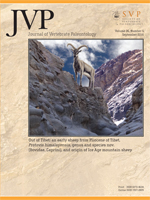A new fossil crocodile, Ultrastenos willisi, is described from a cranium and postcranial materials collected from the Riversleigh World Heritage Area, northwestern Queensland, Australia. The mandible displays pronounced anterior constriction, approaching that seen in the extant gharial, Gavialis gangeticus, and false gharial, Tomistoma schlegelii. As such, U. willisi potentially filled the ecomorphological niche associated with longirostry that has been previously unaccounted for in Riversleigh's Oligo-Miocene crocodile fauna. The pronounced constriction and features of the posterior cranium further distinguish U. willisi from all other known crocodiles, including the only reported Australian Oligo-Miocene longirostral crocodile, Harpacochampsa camfieldensis, from Bullock Creek in the Northern Territory. Ultrastenos willisi is recognized as a new genus and species assigned to subfamily Mekosuchinae on the basis of phylogenetic analysis.
How to translate text using browser tools
1 September 2016
A New Crocodile Displaying Extreme Constriction of the Mandible, from the Late Oligocene of Riversleigh, Australia
Michael Stein,
Suzanne J. Hand,
Michael Archer
ACCESS THE FULL ARTICLE





